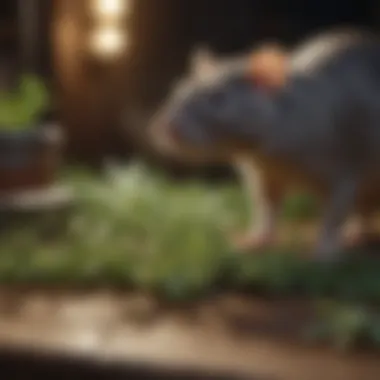Natural Rat Repellents: Eco-Friendly Solutions


Intro
Rats are resilient pests that can infiltrate homes and cause significant damage. Understanding how to manage these intrusions with natural repellents is crucial. This guide aims to provide detailed strategies that are not only effective but also environmentally friendly. Homeowners and renters alike can benefit from insights that prioritize safety while dealing with rodent issues.
Identification of Common Pests
Description of Common Pests
Rats typically found in urban areas include the Norway rat and the roof rat. The Norway rat has a robust body and prefers living in burrows near ground level. The roof rat, conversely, has a slender body and thrives in higher elevations such as attics or trees. Both species can gnaw through wood, wires, and other materials, posing risks to property and safety.
Signs of Infestation
Detecting a rat problem early can save homeowners from costly damages. Common indicators of a rat infestation include:
- Droppings: Small, dark, and tapered droppings are telltale signs.
- Gnaw Marks: Look for damaged food packaging or surfaces, indicating rat activity.
- Nests: Shredded materials, such as paper or fabric, might signify nesting sites.
- Noises: Scratching or scurrying sounds, especially at night, suggest active rodents.
"Early identification is key to effective pest management. Ignoring the signs can lead to a larger infestation, requiring more invasive measures."
Prevention Techniques
Home Maintenance Tips
Maintaining a clean and well-sealed home is essential in preventing rat access. Here are some practical steps:
- Seal Entry Points: Inspect your home for holes or gaps, particularly around pipes, vents, and doors. Use materials like steel wool or caulk to fill these gaps.
- Store Food Properly: Use airtight containers for stored food. Dispose of leftovers quickly and avoid leaving pet food out.
- Regular Cleaning: Keep areas clutter-free and clean up crumbs or spills promptly. A clean environment is less inviting for rodents.
Environmental Modifications
Altering your surroundings can also deter rat infestations. Consider the following:
- Remove Garbage: Ensure trash bins are securely covered and discarded waste is removed regularly.
- Manage Landscaping: Trim bushes and trees that may provide shelter. Avoid dense vegetation close to the house.
- Eliminate Standing Water: Fix leaks and remove standing water, as moisture can attract pests.
Eco-Friendly Pest Control Options
Natural Pesticides
Using natural substances can be an effective means to deter rats without causing harm to the environment. Some options include:
- Peppermint Oil: The strong scent of peppermint can repel rats. Mixing it with water and spraying areas can serve as a protective measure.
- Vinegar: Its strong odor may also deter rodents. A solution of vinegar and water can be applied to potential entry points.
Organic Pest Control Techniques
In addition to natural pesticides, there are organic strategies that can be employed. Consider:
- Predatory Animals: Encouraging natural predators like cats can naturally reduce rat populations.
- Traps: Use humane traps to capture and release rats away from your home, promoting an eco-friendly approach.
By applying these eco-friendly strategies, homeowners can deter rats effectively while maintaining a commitment to sustainable pest management.
Understanding the Rat Problem
Understanding the rat problem is crucial for addressing pest issues effectively. Rats are not just nuisances; they can pose health risks and damage property. Knowledge about their behavior and habitats can help in formulating effective strategies for prevention and control. By comprehending the factors contributing to rat infestations, homeowners can take proactive measures to mitigate risks. This section explores the key aspects of rat behavior and common infestation spots, which aids in recognizing potential threats before they escalate.
An Overview of Rat Behavior
Rats exhibit distinctive behaviors that contribute to their survival and proliferation. They are primarily nocturnal, which means they are most active during the night. This behavior allows them to forage for food while avoiding human interaction. Rats are also highly adaptable, thriving in various environments including urban areas, where they can easily find food and shelter.
Rats typically live in colonies and utilize a system of tunnels for mobility. They are territorial creatures, marking their habitats with scent to communicate with other rats. This instinct to establish dominance can create problems in multi-unit dwellings like apartments. Knowledge of these behaviors helps homeowners understand the best times to set traps and how to conduct thorough inspections.
"The ability to adapt and thrive in diverse environments makes rats particularly challenging pests to manage."
Common Infestations in Urban Areas
Urban environments provide numerous opportunities for rats to thrive. Automobiles, dumpsters, and buildings with poor sanitation practices create perfect conditions for these pests. Common problem areas include:


- Basements and Attics: These dark, undisturbed spaces often become nesting sites.
- Garages: Stored items and rubbish provide both shelter and food sources.
- Parks and Sidewalks: Rats often scavenge for leftovers in community spaces.
In cities, the presence of restaurants intensifies the problem, as discarded food becomes a magnet for rat populations. Significant infestations can lead to food contamination and increased health risks, making it essential for residents to understand these patterns and take preventative measures.
Identifying hotspots for infestations in urban settings is the first step to managing the rat population. By maintaining cleanliness and securing entry points, residents can make their homes less attractive to these rodents.
The Importance of Natural Repellents
Natural repellents are becoming increasingly significant in the context of pest management. This shift towards eco-friendly strategies is not merely a fad; it resonates with deeper environmental and health considerations. With growing awareness about the adverse effects of chemical pesticides on both human health and the ecosystem, the demand for natural alternatives is on the rise. These repellents not only help in keeping rats away but also align with sustainable living practices.
Natural repellents, such as essential oils and certain herbs, offer dual benefits. They can deter pests while maintaining a safe environment for children and pets. By choosing natural solutions, homeowners can create a balanced ecosystem, minimizing harmful impacts on beneficial species.
Furthermore, natural repellents often come with additional advantages. They tend to be less expensive in the long run and available in various forms, making them adaptable to different situations. This article will explore various types of natural rat repellents, emphasizing their effectiveness and practicality.
Benefits of Eco-Friendly Pest Control
The use of eco-friendly pest control strategies is beneficial on multiple fronts. First, it significantly reduces the risk of exposing individuals and animals to toxic substances. Many commercial pesticides contain chemicals that can linger in the environment or cause unintentional harm to pets, wildlife, and humans. Utilizing natural repellents diminishes these risks, promoting safety within your living space.
Moreover, eco-friendly solutions contribute to biodiversity. When we eliminate harmful chemicals, we support the ecosystem's natural balance. This approach weed out the adverse effects on non-target species which are often collateral damage in traditional pest control methods.
Cost-effectiveness is another advantage of utilizing natural repellents. Many of these solutions can be made at home with common household items. This not only saves money but also empowers individuals to take active roles in their pest management strategies.
To encapsulate, the benefits of eco-friendly pest control extend well beyond just repelling rats. It creates a healthier environment, contributes positively to the ecosystem, and promotes more sustainable practices in everyday life.
Avoiding Chemical Pesticides
Avoiding chemical pesticides is crucial in today’s context. The impact of these substances on human health, animals, and the environment has been documented extensively. From respiratory issues to potential carcinogenic effects, the risks associated with synthetic pesticides are a valid concern for homeowners.
Natural alternatives serve as viable solutions to these problems. They provide a pathway to effectively manage pests without introducing chemical hazards into the environment. For instance, essential oils, known for their strong scents, can mask the pheromones that rats use to navigate, making infested areas less attractive.
It's also important to consider the implications of chemical runoff. Pesticides can seep into the soil and waterways, leading to long-lasting ecological damage. Natural repellents, on the other hand, tend to break down more rapidly in the environment, reducing their negative impact.
Thus, avoiding chemical pesticides empowers individuals to take responsibility for their immediate spaces and the broader environment. Making the choice for natural repellents ensures a healthier living situation while supporting sustainable practices.
Natural Rat Repelling Agents
The use of natural rat repelling agents plays a crucial role in sustainable pest management. By employing these agents, homeowners can deter rats without resorting to harmful chemicals. This approach not only protects the environment but also minimizes potential health risks. Understanding various natural repellents can help in developing effective strategies against rat infestations.
Essential Oils as Rat Deterrents
Essential oils are recognized for their strong scents, which can be unpleasant for rats. Each type of oil has its unique properties that contribute to their effectiveness as repellents. Here are three common essential oils used for this purpose:
Peppermint Oil
Peppermint oil is perhaps the most talked-about essential oil when it comes to repelling rats. Its distinctive odor overwhelms rodents’ sense of smell, making it an effective deterrent. This oil also has the added benefit of being safe for use around pets and humans.
One unique feature of peppermint oil is its ability to provide an invigorating aroma while serving its purpose as a pest repellent. However, the disadvantage of this oil can be its volatility; it needs to be reapplied frequently for continual effectiveness.
Eucalyptus Oil
Eucalyptus oil is another strong candidate in the fight against rodent infestations. Its fresh scent is both refreshing for humans but repugant to rats. Eucalyptus not only repels rats but also offers antiseptic qualities.
The key characteristic of eucalyptus oil lies in its natural abundance in many regions, making it accessible to homeowners. Still, one should take care, as dense concentrations can deter not only pests but also beneficial insects, leading to potential imbalances in the garden.
Citronella Oil
Citronella oil is well known for its use in candles but it also serves as an effective rat repellent. Its strong citrus scent can confuse and repel rodents. This oil is often used in outdoor settings but can also find application in indoor pest control.
One unique feature of citronella oil is its versatility; it can be combined with other oils to enhance its effectiveness. However, the disadvantage is that it may not be as potent as peppermint or eucalyptus in affecting rodent behavior.
Herbs and Spices That Repel Rats
Various herbs and spices can also serve as effective rat repellents. These natural options are often easy to source and use in daily life, making them appealing choices for homeowners.
Bay Leaves


Bay leaves are not just culinary ingredients; they can also deter rats. Their scent is unpleasant for rats, making them an easy-to-use repellent. By placing bay leaves in areas prone to infestations, homeowners can discourage rat activity.
The key characteristic of bay leaves is their accessibility, as they are commonly found in kitchens. However, they may need to be replaced frequently to maintain effectiveness.
Garlic
Garlic is known for its strong aroma, which can be offensive to rats. It can be used either fresh or in powdered form. This makes it practical for various applications around the home and garden.
One unique feature of garlic is its dual purpose; it is both a culinary delight and a natural pest repellent. Despite its effectiveness, it needs regular replacement to ensure that its scent remains potent.
Cinnamon
Cinnamon is another household spice that can repel rats. Its pleasant fragrance for humans is yet distasteful to rodents. Homeowners can sprinkle cinnamon in areas where rats are likely to appear.
The key characteristic of cinnamon is its long-lasting aroma, which can serve as a deterrent. However, similar to other spices, it's essential to reapply it regularly, especially in exposure to moisture that can diminish its effectiveness.
Natural Predators and Their Roles
Leveraging natural predators is a classical method in pest control. By encouraging animals that prey on rodents, homeowners can create a balanced ecosystem. Two main approaches involve using cats and attracting bird predators.
Using Cats for Pest Control
Cats are well-known hunters and can be highly effective at controlling rat populations. Their natural instincts makes them ideal for this purpose. In homes where cats reside, the presence of one can deter rats simply through their scent.
The key characteristic of using cats is that they require minimal effort from owners, providing both companionship and pest control. A disadvantage can be the variability in hunting success, as not all cats will actively hunt.
Encouraging Bird Predators
Birds such as hawks and owls also play a significant role in controlling rat populations. Homeowners can encourage these predators by setting up suitable nesting areas. This method relies on fostering a beneficial ecosystem.
The key characteristic of attracting bird predators is that they provide a natural solution to the issue of rats. However, attracting birds often requires more effort in planning and habitat management than using cats, making this option less accessible for some.
Environmental Modifications for Rat Prevention
Environmental modifications play a crucial role in preventing rat infestations. By altering the physical space around homes and properties, one can effectively limit areas where rats can thrive and reproduce. This approach focuses on creating environments that are uninviting for rodents, thereby reducing their chances of entering one's living space. Additionally, it can complement the use of natural repellents and traps, creating a multi-faceted strategy for pest management.
The benefits of such modifications include lower reliance on chemical pesticides, a reduction in rodent populations, and an overall healthier living environment. Homeowners can implement manageable strategies, ensuring both safety and efficacy in the ongoing battle against these pests.
Creating Uninviting Spaces
Sealing Entrances and Holes
Sealing entrances and holes is fundamental in rat prevention. This strategy involves closing off gaps, cracks, and openings where rats might enter a home. A significant aspect of this method is that it limits access points, making it harder for rodents to infiltrate indoor spaces. Materials like steel wool, caulk, or mesh are popular choices for this task.
This approach is beneficial because it addresses the problem at its source. By preventing entry, homeowners dramatically decrease the likelihood of an infestation. However, it requires diligence and ongoing effort to regularly inspect the property for new gaps that may arise over time.
Keeping Areas Clean and Tidy
Maintaining cleanliness is another essential aspect of effective rat prevention. Keeping areas clean and tidy reduces the availability of food and shelter that rats often seek. This involves regular cleaning of all spaces in and around the home. Focus on outdoor areas, such as gardens and patios, where debris may accumulate.
The key advantage of this method is its straightforward nature and immediate impact. An unkempt area acts as an invitation for rats, while a clean space becomes less appealing. Yet, the challenge lies in consistency; frequent maintenance is necessary to ensure that clutter does not build up again.
Landscape Adjustments
Strategic Planting Choices
Strategic planting choices involve selecting plants that are less likely to attract rodents. Certain plants can repel rats due to their natural odors or textures. For example, aromatic herbs such as mint may deter rats while enhancing the garden's overall aesthetics. Choosing tough, thorny shrubs can also act as a barrier to nesting.
This approach is beneficial for homeowners looking to maintain a garden while promoting a pest-resistant environment. Yet, it requires thoughtful consideration of the local ecosystem and how certain plants will interact with others.
Removing Attractants from Gardens
Removing attractants from gardens is critical in minimizing rat presence. This activity includes clearing away fallen fruits, securing garbage bins, and ensuring that compost piles do not contain food scraps. By eliminating these favorable conditions, the chances of attracting rats can significantly decrease.
Exposure to a clean and undisturbed environment will discourage rats from entering garden spaces. However, this approach may necessitate a shift in how one practices gardening and waste disposal to achieve long-term results.


"Creating uninviting spaces and making strategic landscape choices are measures that any homeowner can implement to significantly improve their chances of keeping rats at bay."
By focusing on these environmental modifications, homeowners safeguard their properties from potential infestations. This preventive approach not only aims to control existing problems but also seeks to establish long-term health and comfort in the living environment.
Physical Barriers Against Rodents
Physical barriers serve as a crucial component in preventing rat intrusions. These methods create a strong line of defense against pests. Unlike chemical solutions, physical barriers don’t pose risks to health or the environment. Rodents often find certain access points and establish nests in homes. Therefore, implementing effective barriers can dramatically reduce rat activity.
Fencing and Screens
Types of Fencing Materials
Fencing materials play an essential role in creating boundaries that rodents cannot easily cross. Metal fencing is highly effective due to its strength. Common options include chain link and welded wire. These materials have a key characteristic: they are durable and resistant to wear. Choosing metal fencing can minimize maintenance efforts. A unique feature of metal fencing is its ability to withstand harsh weather, thus providing long-lasting protection. However, the downside might be the initial cost, which can be higher compared to wooden options.
Implementing Wire Mesh Barriers
Wire mesh barriers can provide excellent defense against rodent entry. This strategy involves placing mesh around vulnerable spots in the exterior of buildings. A key characteristic of wire mesh is its small openings, which can effectively block rodents of various sizes. This makes it a beneficial choice for homes looking to maintain safety without using chemical repellents. A unique feature of wire mesh is its versatility; it can be used in basements, under foundations, and around piping. One disadvantage is that it requires careful installation to ensure there are no gaps where rats could slip through.
Traps vs. Repellents
Choosing Effective Traps
Selecting the right traps is vital for an effective pest management strategy. Traps come in various styles, including snap traps and electronic traps. A key characteristic of choosing effective traps is understanding the type of rodent problem you face. Snap traps offer a straightforward, low-cost solution for intermittent issues. Their simplicity makes them a popular choice, especially for individuals new to pest control. An advantage is that they are reusable, which can save money over time. However, the drawback is that they must be checked frequently to ensure they are effective.
Integrating Repellents with Traps
Integrating repellents with traps creates a more holistic approach to rodent control. The key characteristic here is that while traps physically capture rodents, repellents can deter them from entering areas in the first place. This combination often leads to better results. A unique feature of this integration is it reduces the likelihood of a rat becoming trap-wise, as continual deterrence can disrupt their patterns. A disadvantage could be the need for regular maintenance of both traps and repellents to ensure effectiveness.
By incorporating both physical barriers and traps, homeowners can create a comprehensive strategy for rodent management and prevention.
Monitoring and Maintenance Strategies
Effective pest management requires a structured approach. Monitoring and maintenance strategies play a crucial role in keeping rat populations under control. Without consistent monitoring, infestations can escalate quickly, becoming overwhelming for homeowners and renters alike. By establishing an ongoing maintenance routine, you essentially create a buffer against future invasions. This not only involves observing rat behavior and signs of infestation but also making adjustments based on these observations.
Regular Inspection Practices
Regular inspections are vital. Establishing a schedule for assessments ensures that any signs of rat activity are detected early. You should check areas commonly prone to infestations, such as the kitchen, storage areas, and basements.
Some key inspection tips include:
- Look for droppings: Rat droppings are small, dark, and often found near food sources.
- Inspect for damaged wires or insulation: Rats tend to chew on materials, which can lead to larger issues.
- Monitor entry points: Gaps in walls or around utilities can be potential entryway for rats.
- Use traps as indicators: If traps remain untouched, reconsider their placement.
Utilizing a log can be beneficial. Documenting findings and actions taken helps track trends over time. This practice also guides you in adjusting strategies as needed. Monitoring the effectiveness of your natural rat repellents is just as essential.
Sustainable Practices for Long-term Success
Sustainability should remain at the forefront of your pest management approach. Implementing eco-friendly practices can lead to long-term solutions that are both effective and safe for your home environment. Consider the following sustainable strategies:
- Implementing habitat modification: Regularly declutter your home and yard to remove breeding grounds.
- Using natural deterrents: Essential oils or herbs don't just repel rats; they can also enhance the scent of your space.
- Encouraging natural predators: Birds and cats can naturally deter rats, contributing to pest control efforts.
- Promoting community awareness: Engage neighbors in pest management discussions. Collective efforts can lead to greater effectiveness.
"Adopting a holistic view toward rat control encourages sustainable practices that extend beyond the immediate solution."
By combining regular inspections with sustainable approaches, you can maintain an environment that is resistant to rat infestations. Consistency is key; integrating these practices will lead to success in pest management.
Professional Help for Persistent Infestations
Managing rat infestations can be a challenging task for many homeowners. While natural repellents and DIY solutions can be effective to some degree, there are situations where professional intervention becomes necessary. Understanding when and how to seek help from pest control experts is crucial in ensuring effective management of rodent problems. This section delves into the importance of professional assistance and what to consider during this process.
When to Consult Pest Control Experts
It is wise to consider professional pest control services when the infestation is severe and persistent. Some signs that indicate the need for expert help include:
- Consistent Sightings of Rats: If you repeatedly see rats during the day or night.
- Damage to Property: Evidence such as gnawed wires, furniture, or stored goods suggests a significant presence.
- Difficult Access Points: When rats have accessed hard-to-reach areas in a property, it can be hard to manage without tools and expertise.
- Health Concerns: If there are indications that the infestation is causing health risks, like droppings or signs of disease, immediate help is advisable.
Contacting pest control professionals also brings several benefits. They have access to advanced tools and techniques, allowing for a more effective response. Furthermore, experts can provide comprehensive assessments of the property, identify vulnerabilities, and offer tailored strategies that align with eco-friendly practices.
Evaluating Eco-Friendly Pest Control Services
When seeking pest control services, finding one that prioritizes environmentally friendly methods is essential. Here are key points to consider:
- Certification and Reviews: Research the company for eco-friendly certifications. Real customer reviews can offer insights into the effectiveness of their methods.
- Techniques Used: Inquire about the specific strategies they intend to use. Services that employ traps, exclusion tactics, and natural repellents are preferable.
- Safety Protocols: Ensure that the service uses non-toxic materials trained with safety measures. This is especially important if there are small children or pets in the household.
- Post-Treatment Support: A reputable pest control provider should offer follow-ups and maintenance plans to prevent re-infestation. This could include regular inspections and advice on pest-proofing.







